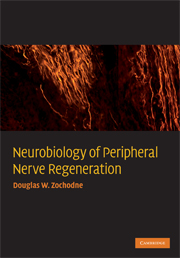Book contents
- Frontmatter
- Contents
- Acknowledgments
- 1 Introduction
- 2 The intact peripheral nerve tree
- 3 Injuries to peripheral nerves
- 4 Addressing nerve regeneration
- 5 Early regenerative events
- 6 Consolidation and maturation of regeneration
- 7 Regeneration and the vasa nervorum
- 8 Delayed reinnervation
- 9 Trophic factors and peripheral nerves
- 10 The nerve microenvironment
- References
- Index
- Plate section
- References
10 - The nerve microenvironment
- Frontmatter
- Contents
- Acknowledgments
- 1 Introduction
- 2 The intact peripheral nerve tree
- 3 Injuries to peripheral nerves
- 4 Addressing nerve regeneration
- 5 Early regenerative events
- 6 Consolidation and maturation of regeneration
- 7 Regeneration and the vasa nervorum
- 8 Delayed reinnervation
- 9 Trophic factors and peripheral nerves
- 10 The nerve microenvironment
- References
- Index
- Plate section
- References
Summary
Nerve regrowth has a context, a microenvironment replete with molecular, physical, and other determinants of success. Some are roadblocks, others are partners. The growth factors considered in Chapter 9 are only part of the story of how nerves fare during regeneration. In this chapter, we consider a number of other salient features of the regenerative milieu that influence regeneration. These range from adhesion and basement membrane molecules, to novel signaling systems to interactions within altered environments as occur during aging, diabetes mellitus, or entry into the spinal cord.
Adhesion molecules
Cell adhesion molecules (CAMs) represent the interface between axons, SCs, and the basement membrane. They provide the essential extracellular “clutch” domains that allow differential movement of membranes and molecules along one another. During nerve regeneration, adhesion molecules permit axon growth with basement membranes, along guiding SC processes, or with other fasciculating axons guided by pioneer axons. In turn, the linkages of CAMs to the intracellular cytoskeleton influence cell mobility. To accomplish their task, CAMs can interact with each other (homophilic) or other molecules (heterophilic). These interactions vary in adhesive strength depending on the location and intensity of their expression, distribution on a given cell, and electrical charge.
Three major families of CAMs are recognized. The immunoglobulin (IgCAMs) family contains extracellular β sheets that resemble the variable or constant domains of immunoglobulins (Igs). This family is further subdivided into three types, depending on the type of Ig domains and the presence of fibronectin-like or other extracellular domains.
- Type
- Chapter
- Information
- Neurobiology of Peripheral Nerve Regeneration , pp. 206 - 219Publisher: Cambridge University PressPrint publication year: 2008



